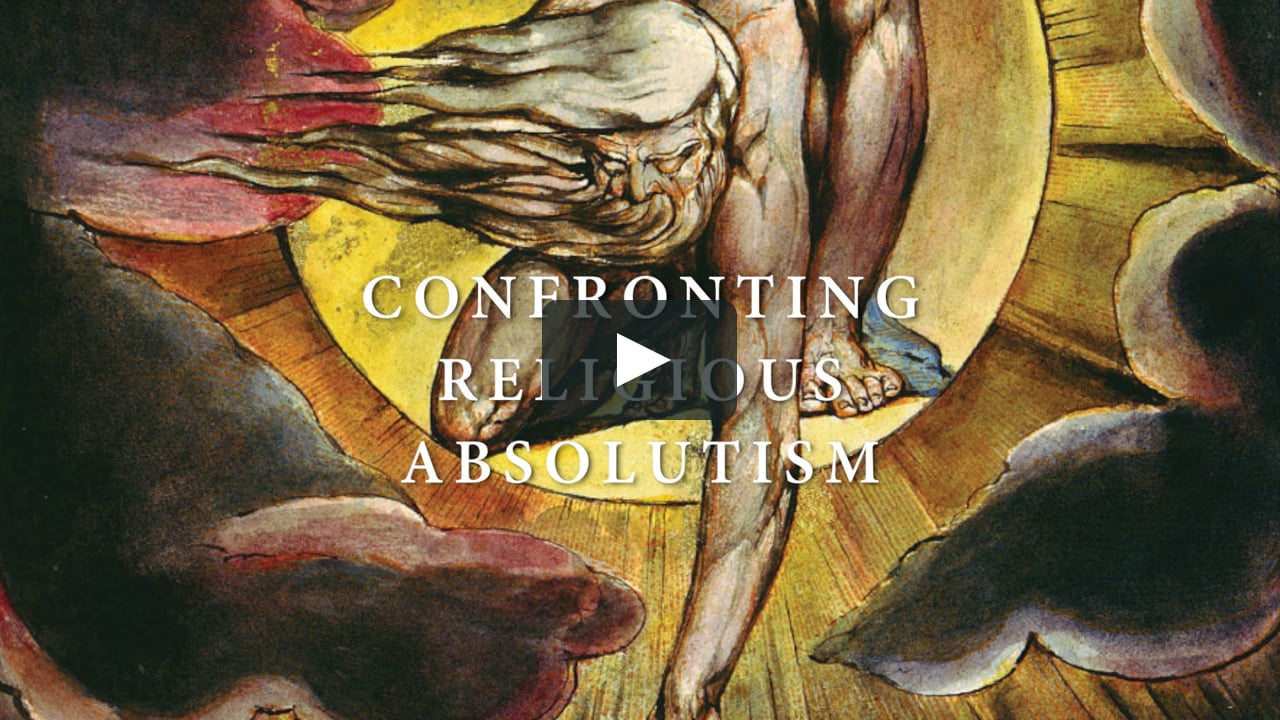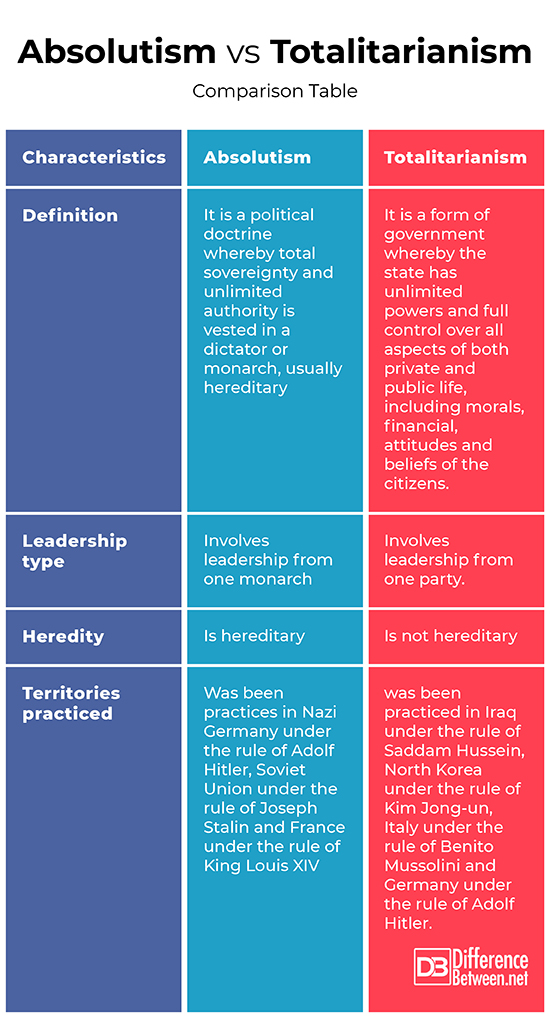Difference Between Absolutism and Totalitarianism
The importance of governance in a state or nation cannot be underestimated. Various forms of governance have hence been experienced in different states, with some being outdated. Examples of forms of governance include authoritarianism, totalitarianism, fascism, and absolutism. Although these forms of leadership are different in many ways, the boundaries are poorly defined, have overlapping characters and are fluid, hence many are not able to differentiate them. Although they are similar in some ways, absolutism and totalitarianism have various differences.
What is Absolutism?
Developed in the 16th and 17th century, this is a political doctrine whereby total sovereignty and unlimited authority is vested in a dictator or monarch, usually hereditary. The ruling power is hence not subjected to check by any other party.
The Monarch is the most common form of absolutism, with the origin of Europe. This was however as a result of the breakup of the medieval order which led to new nations hence strong leaders. The power of the states was associated with the power of its leaders, which led to a monarch kind of leadership.
Territories where absolutism has been practiced include;
- Nazi Germany under the rule of Adolf Hitler
- The Soviet Union under the rule of Joseph Stalin
- France under the rule of King Louis XIV
What is Totalitarianism?
Developed by Italian fascists in the 1920s, this is a form of government whereby the state has unlimited powers has full control over all aspects of both private and public life, including morals, financial, attitudes and beliefs of the citizens. Developed in a bid to set positive goals for the nation, this model of governance has been rejected by most western governments and civilizations.
Characteristics of totalitarianism governance include;
- Ruled by one dictator
- Lack of freedom in religious and political practices
- Forced population control measures
- Ruled by a single, ruling political party
- Forced military service to the citizens
- Enforcement of laws by the military
- Full control of the press
These ruling techniques only cause more harm into the citizens by instilling fear to the citizens.
Some of the states ruled under totalitarianism include:
- Iraq under the rule of Saddam Hussein
- North Korea under the rule of Kim Jong-un
- Italy under the rule of Benito Mussolini
- Germany under the rule of Adolf Hitler
Similarities between Absolutism and Totalitarianism
- In both, the ruling party is not subjected to checks by any other agency
Differences between Absolutism and Totalitarianism
Definition
Absolutism refers to a political doctrine whereby total sovereignty and unlimited authority is vested in a dictator or monarch, usually hereditary. On the other hand, totalitarianism is a form of government whereby the state has unlimited powers and full control over all aspects of both private and public life, including morals, financial, attitudes and beliefs of the citizens.
Leadership type
While absolutism involves leadership from one monarch, totalitarianism involves leadership from one party.
Heredity
While absolutism is hereditary, totalitarianism is not hereditary.
Territories practiced
Absolutism was been practices in Nazi Germany under the rule of Adolf Hitler, the Soviet Union under the rule of Joseph Stalin and France under the rule of King Louis XIV. On the other hand, totalitarianism was been practiced in Iraq under the rule of Saddam Hussein, North Korea under the rule of Kim Jong-un, Italy under the rule of Benito Mussolini and Germany under the rule of Adolf Hitler.
Absolutism vs. Totalitarianism: Comparison Table
Summary of Absolutism vs. Totalitarianism
Absolutism refers to a political doctrine whereby total sovereignty and unlimited authority is vested in a dictator or monarch, usually hereditary. On the other hand, totalitarianism is a form of government whereby the state has unlimited powers and full control over all aspects of both private and public life, including morals, financial, attitudes and beliefs of the citizens.
- Difference Between Profit Center and Investment Center - July 2, 2022
- Difference Between Anti-Trust and Anti-Competition - June 6, 2022
- Difference Between Stocktaking and Stock Control - June 6, 2022
Search DifferenceBetween.net :
Leave a Response
References :
[0]King Preston. The Ideology of Order: A Comparative Analysis of Jean Bodin and Thomas Hobbes. Psychology Press, 1999. https://books.google.co.ke/books?id=skx5JTYQ9z0C&pg=PA37&dq=Difference+between+Absolutism+and+Totalitarianism&hl=en&sa=X&ved=0ahUKEwiLrNSzwZLmAhUKmBQKHSJzB7YQ6AEIKzAB#v=onepage&q=Difference%20between%20Absolutism%20and%20Totalitarianism&f=false
[1]Hannah Arendt . Totalitarianism: Part Three of The Origins of Totalitarianism. HMH Publishers, 1968. https://books.google.co.ke/books?id=I0pVKCVM4TQC&pg=PT111&dq=Difference+between+Absolutism+and+Totalitarianism&hl=en&sa=X&ved=0ahUKEwiLrNSzwZLmAhUKmBQKHSJzB7YQ6AEIWDAH#v=onepage&q=Difference%20between%20Absolutism%20and%20Totalitarianism&f=false
[2]Milan Zafirovski. The Protestant Ethic and the Spirit of Authoritarianism: Puritanism, Democracy, and Society. Springer Science & Business Media, 2007. https://books.google.co.ke/books?id=QUJFYLONL8cC&pg=PA18&dq=Difference+between+Absolutism+and+Totalitarianism&hl=en&sa=X&ved=0ahUKEwiLrNSzwZLmAhUKmBQKHSJzB7YQ6AEIUDAG#v=onepage&q=Difference%20between%20Absolutism%20and%20Totalitarianism&f=false
[3]Image credit: https://live.staticflickr.com/3387/4594946403_d4114cd63f_b.jpg
[4]Image credit: https://i.vimeocdn.com/filter/overlay?src0=https%3A%2F%2Fi.vimeocdn.com%2Fvideo%2F598360319_1280x720.jpg&src1=https%3A%2F%2Ff.vimeocdn.com%2Fimages_v6%2Fshare%2Fplay_icon_overlay.png



